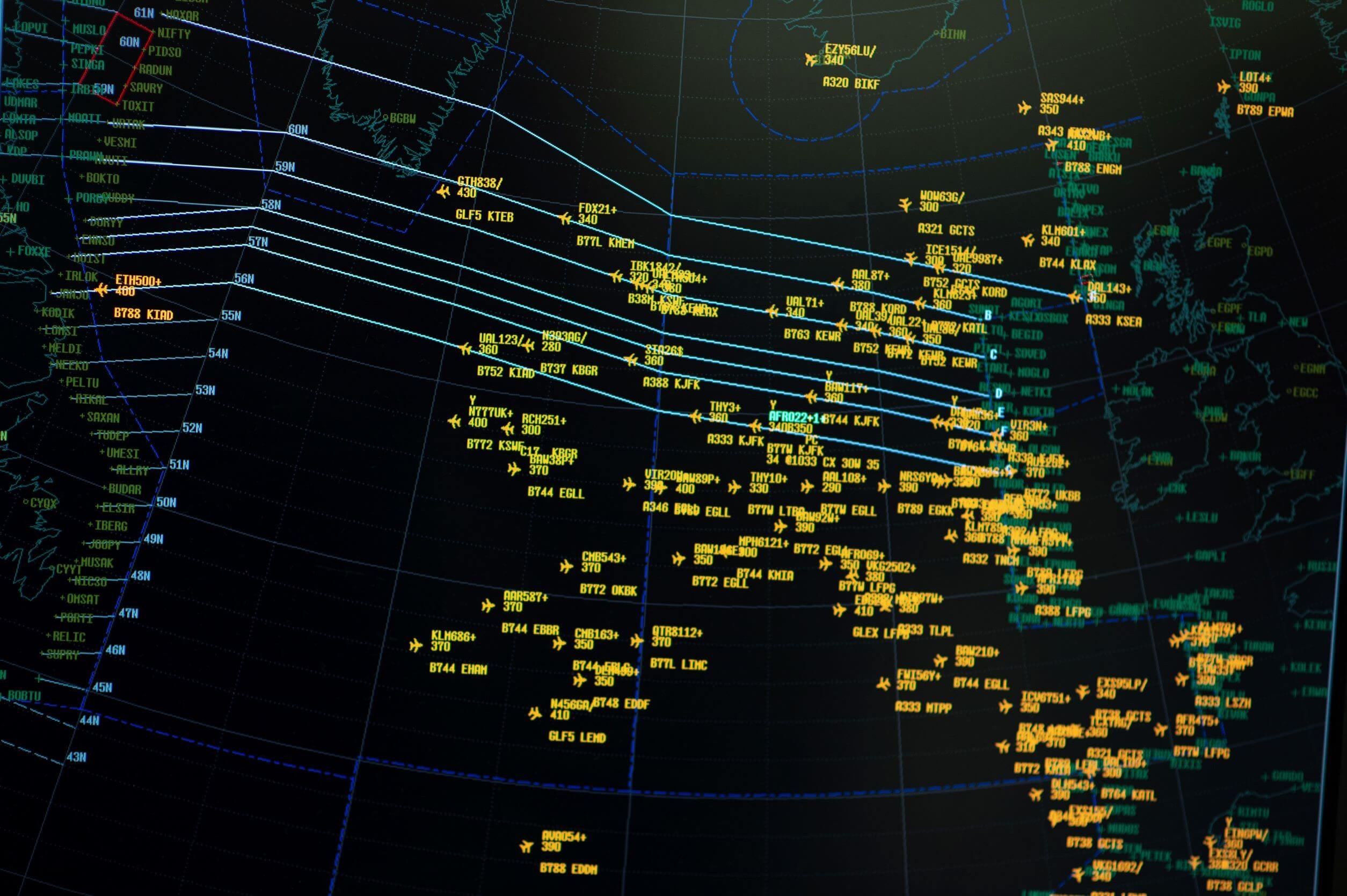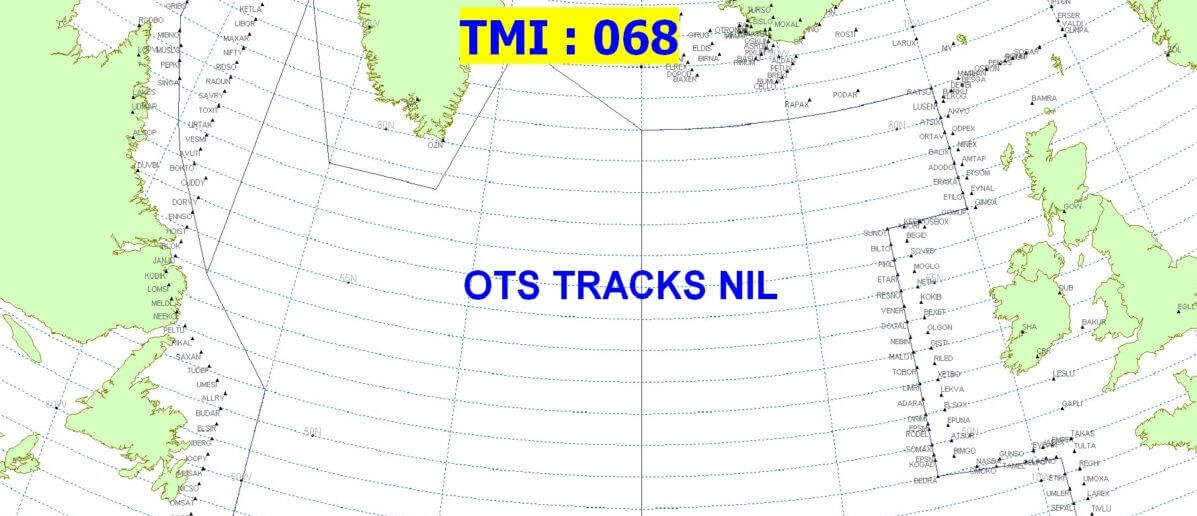This article was originally published on March 1, 2022.
Big changes are happening over the North Atlantic, the busiest piece of Oceanic airspace in the world.
Since the 1960s, a system of organized tracks, like a multi-lane highway in the sky, has been in place for any airline wishing to cross from Europe to North America and vice versa.
But the advent of satellite-based tracking of planes, also known as space-based ADS-B, is enabling air traffic controllers, led by the UK NATS, to shake up the Organised Track System (OTS) and even get rid of it entirely on certain days. It’s all part of efforts to help planes fly more efficiently across the Atlantic, saving time, money, fuel and CO2 emissions.
AeroTime spoke to Jacob Young, a former Oceanic controller and supervisor who is now manager operational performance at NATS, about the changes.
“It’s been probably some of the most transformational times that we’ve had since I’ve been at NATS,” Young says. “Space-based ADS-B and the COVID-19 pandemic are the two key drivers that have let us move to OTS nil on certain days.”
What is the OTS?
Prestwick ops tracks Credit: NATS
The OTS consists of up to 12 tracks, published each day, to cover the peak traffic flows between Europe and North America. A westbound flow departs Europe in the morning, while an eastbound rush leaves North America in the evening. These tracks take into account weather and especially the jetstream, airlines’ preferred routes and airspace limitations, including if the military is using airspace, to provide the most efficient routes across the Atlantic.
Traditional radar doesn’t provide coverage over the oceans, so air traffic controllers used to rely on automated messages, known as ADS-C, sent from aircraft every 14 minutes. These provide controllers with details of an aircraft’s position and its next expected position. Because of this lack of real-time data, aircraft had to be separated by 40 nautical miles (74km) to ensure adequate safety margins. With these constraints in mind, the OTS has helped to manage this busy airspace and provided predictability and safety for controllers and airlines since the 1960s.
“We use a motorway analogy,” explains Young. “If aircraft are allowed to free-flow across the motorway, there’s more chance that they are going to cross in front of each other, and we can’t permit them to do that. Whereas if everyone has to stay in their own lanes, then they’re already laterally separated from each other.”
While airlines were allowed to request ‘random’ routes, these often had to be changed at short notice to maintain separation, causing uncertainty for airlines and increasing the workload of controllers.
How are things changing?
It may seem crazy but, up until a few years ago, there was no way to track aircraft in real time across oceans, due to the lack of radar coverage. This was made apparent by the still unexplained disappearance of Malaysia Airlines MH370 in 2014. The lack of real-time tracking was also highlighted in the crash of Air France 447 in 2009, when it took two years to find the wreckage.
That has now changed thanks to satellite technology. Since 2019, NATS has been working with Aireon to use satellites to track ADS-B signals sent out by aircraft. This means that controllers can receive aircraft position updates every seven to eight seconds, rather than every 14 minutes, over the Atlantic.
“Previously, you were almost always working on out-of-date data. When space-based ADSB was turned on, suddenly, you’re spotting everything that’s happening quickly,” Young says.
The technology has transformed the way that Oceanic controllers work and allowed them to reduce the separation between aircraft on the Atlantic down to 14 nautical miles, from the previous 40nm.
The reduced separation minima means airlines can request more random, or individual routes, outside of the track system.
The lower traffic volumes as a result of the COVID-19 pandemic also helped. Pre-pandemic, there would be about 1,000-1,500 flights a day across the Atlantic. In summer 2021, that had dropped to around 500-600 flights a day, or roughly 50% of pre-COVID levels.
As COVID-19 resulted in fewer flights, there were some days when around 80% of traffic was using random routes, compared with approximately 60% pre-pandemic. Young says that, despite the increase in random routes, the system was working efficiently and that gave NATS the confidence to push for days with zero tracks on the OTS.
In total, there were 20 days in 2021 with no tracks under the OTS. The first such day was March 9, 2021.
“Effectively, we proved that this is a valid option for the future,” Young says, adding that there were no complaints from customers or major issues.
OTS tracks Nil on March 9, 2021 Credit: NATS
Better dealing with emergencies?
Furthermore, the real-time information means controllers can spot any deviations from planned flight paths and start to prepare for any problems or emergencies pilots may be dealing with.
For pilots dealing with an emergency, the priorities are aviate – navigate – communicate. Without real-time data, controllers were clueless until the crew got to the ‘communicate’ part, and could only start to react once pilots got in touch.
Now, they can spot the clues that something is amiss sooner. For example, ADS-B data includes selected flight level, so controllers can see if an aircraft is entering a descent that is not scheduled.
“During emergency situations, such as diversions for medical reasons, we can see that the aircraft is looking to do something before we’ve even had the communications,” Young explains.
“It means you can start thinking about plans straightaway, such as options for deviations or for aircraft to return. So that by the time the comms come in, the controllers are set up and ready to go. We never had that before. Previously, it was comms first, and then react afterwards. Now we can see things first and start planning. It’s huge.”
View of NATS Prestwick operations Credit: NATS
Taking the next steps
North Atlantic traffic is currently at around 80% of 2019 levels and NATS is expecting this to increase to 90-95% in summer 2022.
NATS says it is able to abolish the OTS system now, with just a few minor procedural and system tweaks. However, Young explains that NATS is keen to hear what its customers actually want.
“Do we want total elimination of the OTS? And by we, I mean the airline community as a whole. Or are we looking for a reduction down to one or two tracks a day?”
NATS has started some analytics in cooperation with 15 airlines to see what benefits it could bring them.
“We anticipate what will be a big driver is to see what fuel burn savings can be made. A study showed that every minute saved on the ocean equates to £51 saved for the airlines and we need to see if that translates into reality,” Young says.
Until a decision has been made, the OTS system will likely have at least one track per day, although Young doesn’t rule out any days with zero tracks if traffic dictates.
In a first step, NATS is removing the OTS structure from FL330 and below. Although operators could apply for random routes in that airspace before, many companies had restrictions that prevented them from crossing or joining the track system. Young says this could especially benefit cargo flights running in the opposite direction to the tracks, for example.
“We’re hoping this opens up the opportunity for them to just flight plan their most optimal routes, and flight level. Wherever possible we will then issue them with that request.”
Satellite tracking is certainly changing operations across the North Atlantic. It seems impossible to think that, just two years ago, we could only check up on aircraft in this busy airspace every 14 minutes. Now satellite technology is keeping passengers safer and helping to save CO2 emissions.




